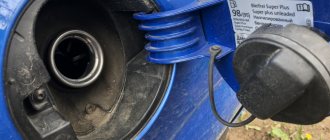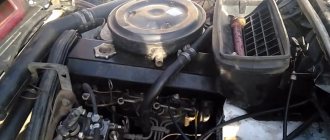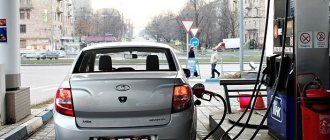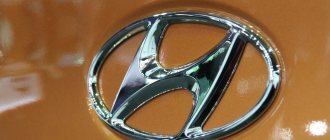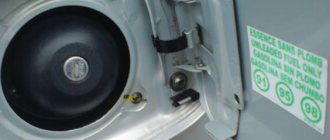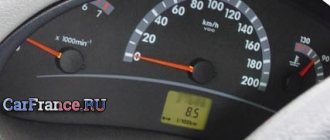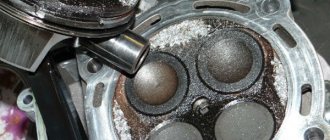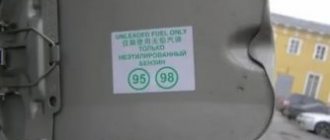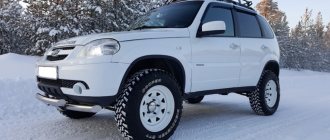- February 7, 2019
- Cars
- Victoria Slaviy
Many car owners often ask the question: which gasoline 92 or 95 is more suitable for the Chevrolet Niva? Looking ahead, we note that this question does not have a definite answer, so each time we need to take into account many factors, different components, and based on them, make one decision or another. There are situations and scenarios when the use of 92 gasoline is justified, and there are those when it is better to buy 95. The materials in this article will help you understand all the nuances.
What kind of gasoline did the Chevrolet Niva originally run on?
The car was originally designed for 92. Why? Because, according to statistics, it is more common, which is logical. After all, its production is cheaper and easier than 95. That is why 92 gasoline is written on the gas tank flap. This does not mean that you cannot fill with 95, but shows that the car can be refueled at a larger number of gas stations, including in the outback, where there may not be 95 gasoline at all. So, the designers designed the car to run on a more popular type of fuel to increase the likelihood of finding the right one. Therefore, there are no strict recommendations on what kind of gasoline - 95 or 92 - the Chevrolet Niva can be filled with. The choice is yours.
conclusions
By following these simple rules, you will save yourself from the expenses and hassle that may arise when repairing an engine. And you may need it at any time if you don’t fill your car with good fuel.
I fill both 92nd and 95th. My swallow rides equally well in the first and second. The point here is not the name, but the quality of the gasoline; you need to be smart about choosing the gas station at which you fill it.
I bought a Chevrolet Niva in 2013 second hand. I tried to fill it with 95, but I didn’t feel a noticeable difference, to be honest, because before that I rode with 92 and didn’t have any problems. Now the mileage is 450 thousand on 92 and I think there is no point in paying more.
I also filled in 92 and 95, I didn’t feel much of a difference, so I fill in with 92. At some gas stations, after 92, the car could barely drive, so I fill up at more or less proven gas stations.
I always fill it with 92, the car drives great. The main thing is a proven gas station, di and besides, 95 is a little expensive to fill.
I fill it with 95, as it is written in the factory operating instructions for a 2010 Chevy Niva, if I need to grab it and there is no normal gas station with 95 gasoline nearby, then I fill it with 92. On it, the power of the car drops slightly and the consumption is higher. At 95, consumption on the highway, at a speed of no more than 110 km/h, is less than 8 liters, in the city about 12, depending on the time of day and the number of vehicles.
Niva-Chevrolet 2013, I fill up with 95, sometimes I fill up with 92 (there was no other) - you immediately feel a loss of power when accelerating, and the engine also sounds a little unstable.
At 95 it behaves noticeably better...
I fill it with 95′, there is no soot on the spark plugs, less consumption and stable operation. Yes, the difference in price is 1 ruble.
The path to convert 80 and 92 gasoline into 95
Tetraethyl lead as a means of increasing octane number was discovered in 1921. In order not to frighten people with the word lead, it was replaced by the more euphonious ethyl. The manufacturing company was well aware of the toxicity of thermal power plants, since in 1934, in the poorly ventilated premises of the company, five workers died and dozens went crazy.
In our country, leaded gasoline was banned on November 15, 2002 by Federal Law No. 209067-3 “On limiting the circulation of leaded gasoline in the Russian Federation.” At first glance, it may seem that now 95 gasoline can be safely filled without fear of poisoning, but in reality everything is much more complicated.
Formally, leaded gasoline, which disables the electrics of the Chevrolet Niva, is prohibited, everyone knows about this, however, few people know that, according to independent researchers, the intensity of pollution with lead compounds near highways is only increasing. This means that it must be stated that leaded gasoline can still be found in the column labeled 95. That is, the possibility of poisoning still exists. Therefore, we can give the most reasonable answer to the question: “Which gasoline, 92 or 95, is more suitable for the Chevrolet Niva.” Any, but without lead!
Is it worth using fuel with different characteristics?
The only difference in using A-95 is that you have to pay a little more at gas stations. The octane number of 95 and 92 gasoline differs by only 3%.
But the use of A-98 and A-80 can create certain problems.
Consequences of using fuel that does not comply with the manufacturer’s recommendations:
- A-80 - detonation, increased fuel consumption, decreased power, accelerated wear of piston system parts.
- A-98 - formation of carbon deposits on spark plugs, overheating and burning out of exhaust valve plates, as well as the surfaces of seats in the engine head.
About choosing a permanent refueling
How to choose a permanent refill? Chat with the owners, read forums or motorist groups in contact. Statistics collected among Chevrolet Niva owners showed that the vast majority of owners make an average trip of one hundred kilometers. This means that it is possible to refuel strictly at one gas station. Therefore, those who drive a little are strongly recommended to choose a gas station that you trust and try, first fill up with 92, drive, observe, then 95. Compare fuel consumption, dynamics. And then, having chosen one brand or another, strictly refuel the car strictly at one gas station.
Manufacturer's requirements
Requirements allow the use of both 92 and 95 gasoline
Before deciding for yourself what kind of gasoline to pour into the tank of your car, you should read the instructions for its operation. Similar information may also be written on the inside of the fuel tank cap. It is recommended to use only the gasoline specified by the manufacturer. For Niva Chevrolet this is the 92nd.
Is it possible the 95th?
AI-95 can also be poured into the tank. There will be no harm to the car from this. As a result, the dynamics of transport will only increase, fuel consumption will decrease, and engine performance will improve. In terms of money, it will cost about the same, despite the fact that AI-95 is more expensive. Its consumption will be less.
It should also be remembered that 92 is common today in the Russian Federation, and therefore there is a possibility that it is diluted during production. Here everything will depend on this or that gasoline supplier to the market.
GOOD – HOW IS IT?
Good gasoline is simple: with it the car “drives” and “your fingers don’t twitch.” In addition, on a frosty morning the engine starts relatively easily; after refueling, there is no need to change spark plugs, a lambda probe, a neutralizer, or flush the fuel system. What does this depend on? Let's start with the main thing...
BLACK EYES, GLORIOUS EYES
Detonation is an eternal topic: “Our Help” once again reminds us of it. So, in order for gasoline to not be afraid of detonation, its molecules must be, as chemists say, stable. The degree of stability is precisely determined by the octane number!
According to the current GOST R 51105-97, all gasolines are divided into four groups based on their octane number - “Normal-80”, “Regular-91”, “Premium-95” and “Super-98”. The higher the octane number, the higher the stability of gasoline, the better they resist detonation. These 80, 91 and others like them are the so-called OCNI, that is, octane numbers determined by the research method. There is also the main frequency, which is determined by the motor method. What is the difference?
Contrary to the well-known misconception, the personal feelings of the researcher or mechanic have nothing to do with it. Both the OCHI and the OCHM are determined on a special single-cylinder installation with a variable compression ratio - UIT-65 or UIT-85. It has three simple carburetors that allow you to dynamically change the composition of the mixture, as well as three small fuel tanks. The test gasoline is poured into one, and two reference gasolines are poured into the other two: their octane numbers must differ by two units. A piezoquartz detonation sensor is hung on the cylinder block, which allows one to evaluate its intensity both on standard gasoline and on the test gasoline - from there the required OC is calculated. The principle of determining both the OCHI and the MVN is the SAME, they just use different operating modes of the installation. For OCHI, the engine is spun up to 600 rpm, and for OCChM - up to 900 rpm, and the mixture is heated in the intake receiver. It is generally accepted that the OCH conditionally models detonation conditions in the urban cycle, and the OCH conditionally models the detonation conditions in the highway cycle. They are connected simply: for A-80 gasoline, the ROM should be 76; for 91 – 82.5; for 95 – 85; for 98 – 88. And the gasoline marking corresponds exactly to OCHI!
Which gasoline, 92 or 95, is more profitable for the Chevrolet Niva?
If for simplicity we assume that both are of the same quality, then, according to numerous reviews from the forums, the financial costs are the same.
Gasoline 95 is a little more expensive, but this is compensated by:
- Significantly lower fuel consumption, also because in some situations it allows driving in a higher gear under the same conditions.
- The dynamics of the car improves, the smoothness of maneuvers increases, and the driver is more comfortable driving the car.
- Since fuel consumption is 95% less, the car will need to be refueled less often (at least by 5 percent, but still). And this is tantamount to increasing the fuel tank, which is extremely important for traveling long distances.
It’s up to you to choose what kind of gasoline to pour into your Chevrolet Niva! Therefore, you can navigate according to your budget.
Myths about saving
There are several ways to reduce fuel consumption: maintaining an ideal technical condition of the engine, a calm driving style.
However, sellers offer a variety of miracle devices and fuel additives that (allegedly) reduce gas mileage by an amount that is limited only by the imagination of marketers.
You need to be extremely careful here. Magnetic attachments and other mechanical “miracles” only harm the pocket of a gullible buyer. But with fuel additives to save fuel, everything is much worse.
Only fuel system cleaners really improve performance. However, in this case it is better to clean the injectors yourself. Chemically active additives can harm the plastic and rubber of fuel lines.
The biggest problem is with economy additives. At best, these are harmless additives that will not affect the operation of the engine in any way. At worst, the additive will cause carbon deposits on the spark plug electrodes and contamination of the injectors. In this case, it will take a lot of money to eliminate the consequences of trying to save money.
Modern internal combustion engines have been practically brought to perfection. If their efficiency could be increased by additives or devices built into the fuel system, they would be actively used by airlines and large cargo carriers.
How to determine the quality of gasoline by smell?
There is a simple but reliable way to determine whether gasoline contains harmful additives. To do this you need to smell gasoline. If after three minutes a clearly noticeable odor remains, this indicates that the gasoline contains additives to increase the octane number. Such gasoline can only be poured into a carburetor car. On the other hand, if the smell disappears too quickly, this is also not in favor of quality, the car will pull worse. The norm is about three minutes of distinct odor. Therefore, when choosing what kind of gasoline to fill your Chevrolet Niva with, take something that holds the smell for three minutes. Or follow the advice of experienced owners from among your friends.
What else has changed in OTTS?
Many fishing enthusiasts will be pleased to learn that the five-door LADA 4×4 is now officially allowed to carry trailers and boats, respectively. "Long Niva", or VAZ-2131, is a legal cut. And to prevent the car from being torn in half, it was previously prohibited to tow trailers on it. Now, on a 3- and 5-door LADA 4×4, you can legally haul trailers with a load capacity of up to 600 kg, provided that this trailer is equipped with a braking system.
Let us remind you that in August at the MIAS-2018 exhibition, the public was shown a prototype of the new LADA 4×4, which is built on the basis of the Renault Duster. The new product was greeted with great interest, I really liked the car, but it is not yet known when it will reach the assembly line.
Source
How to assess the quality of gasoline by its drying mark
We take the glass and drip fuel onto it. In three to five minutes it should evaporate, look at the sediment, at the trace. Attention:
- if the stain is barely noticeable, then the gasoline is good;
- if the trace is blue with streaks and oil stains, then this hints at the presence of diesel fuel and fuel oil;
- if the trace is white, then it is acetone;
- white drops indicate water.
Important! If the car stalls after 500-2000 meters, then this is almost certainly a fuel problem. Therefore, when choosing which gasoline is best to fill in the Chevrolet Niva, it is also important to take into account that it should not leave streaks on the control glass.
Engine roots
First, let's remember what served as the basis for the Niva engine. These are the famous Zhigulis and the first Nivas. And they drove, by the way, on 92 gasoline. Therefore, the conclusion here is obvious - you can fill it, but is it wise?
Many car owners are sure that 92 gasoline and 95 gasoline have few differences and are poured the other way around. But are these savings justified? This has yet to be sorted out.
When is the best time to refuel?
On the forums of Chevrolet Niva owners, they say that the best time to refuel the car is before 9 a.m., before the fuel is drained from the fuel truck, because most gas stations have coarse filters, and after the fuel truck drains it, all the dirt from the day rises to the top. We remember that the working day of a fuel truck driver begins at eight in the morning. Experienced people already know at which gas stations, at what time they need to fill up in order to fill with the purest gasoline possible - you can also read about this on thematic forums.
adding a comment
The “ten” showed the best acceleration, elasticity and maximum speed on AI gasoline. The difference in performance is noticeable, although it cannot be called significant.
The driver will probably feel slight changes in the behavior of the car - in the “ninety-five” VAZ drives a little smoother and more confidently.
It was not possible to detect the difference in gasoline consumption - hundredths of a liter are, rather, an acceptable measurement error. Real indicators are not difficult to explain from a theoretical point of view. Electronic engine management systems, including those on the test VAZ, include a knock sensor, which adjusts the ignition timing.
When the engine runs on high-octane gasoline, the control unit increases the ignition timing, and the values of many parameters that determine power and economic performance change. In other words, theoretically, with high-octane gasoline, consumption decreases slightly, power and torque increase.
In our case, high-octane gasoline added kilowatts and newton meters, which affected the dynamics of the VAZ. It is likely that a car of some other brand will have a more noticeable difference in costs than in power indicators. In any case, only devices will be able to catch it - by eye everything will be approximately the same!
A VAZ consumes an average of about 8 liters of gasoline per km. This means that if you fill in “ninety-fifth”, then every thousand kilometers with the current difference in prices for AI and AI will cost 80 rubles more.
In our case, high-octane gasoline added kilowatts and newton meters, which affected the dynamics of the VAZ. It is likely that a car of some other brand will have a more noticeable difference in costs than in power indicators.
Chevrolet Niva what gasoline 92 or 95
In any case, only devices will be able to catch it - by eye everything will be approximately the same! Do no harm with the wrong gasoline VAZ consumes an average of about 8 liters of gasoline per km. This means that if you fill in the ninety-fifth, then every thousand kilometers with the current difference in prices for AI and AI will cost 80 rubles more.
With an average mileage of 20 thousand. Relative to total fuel costs, the money is small. But the list of additional expenses has not yet been exhausted.
Would you like a lollipop and a ride on a charabanc? The difference in the cost of two cans of gasoline, AI and AI, used for the test, is laid out on the hood. Some car enthusiasts straightforwardly believe: Many years of operation of editorial cars on different grades of gasoline have proven that the AI that is offered at ordinary Russian gas stations quickly disables spark plugs.
On some cars they have to be changed every thousand. This is confirmed by car repair specialists. So they started up even on gasoline. We drove to a local gas station and filled up with rubles worth of gas.
In total, per km we spent rubles on fuel, plus rubles on lunch in cafes - for two, when last year we drove a six, we spent only rubles. So yes - Chevy Niva eats more, especially in the city - it turns out to be liters On the highway at optimal speed in optimal gear - liters Read my blog, subscribe, spring and summer are coming - there will be a lot of travel, which means there will be photo reports on fishing and searching with a metal detector.
- A-92 [16.90%]
- A-95 [57.75%]
- A-95 premium [12.68%]
- I mix 92 and 95 [8.45%]
- GAS [4.23%]
Below we bring to your attention an article from the magazine.
Magazine "Behind the Wheel" 2005 No. 1 Author: Maxim Sachkov
The idea matured at a gas station, where the owners of two identical “ten” cars almost simultaneously drove up to different pumps: one said “92”, the other, respectively, “95”. What does the driver get and what does he lose by choosing one of these types of gasoline?
In the smoking room, the opinions of colleagues were divided - some argued that there was no difference in the behavior of the machine, others insisted on the opposite. My interest was fueled by an acquaintance of mine, the owner of a new foreign car, who often fills it with “ninety-five” (although the operating manual contains fuel with a lower octane number). Like, AI-95 is cleaner, and the car drives better. It became clear that the dispute would be decided only by measurements at the test site.
Underfilling at gas stations
Another common problem with many gas stations is underfilling. We have never heard of overflow. But several programs and stories have even been filmed about underfilling. There are known cases when underfilling of fuel was done deliberately and was even regulated remotely from the office, and when a person arrived with a measuring canister, they turned on a small overflow, which greatly surprised motorists. But at most gas stations it is forbidden to pour fuel into cans, so that they don’t have a half-empty container poked in their noses. It is best here, as in the cases described above, to choose a gas station that either does not underfill or is less deceptive.
Bad news for fans of the brand
For those who drive these cars, the news about the official transition to 95 gasoline may seem insignificant; they have been filling up with 92 gasoline and will continue to do so. But there is one very big problem. VAZ engines do not differ in quality, and buyers quite often turn to the dealer with complaints about the engine’s performance. Apparently, now dealers will be required to carry out an examination of the fuel in the tank, and if they find out that 92-grade gasoline is filled, they will refuse free repairs.
Some general tips
You shouldn’t think that some gasoline is better to fill in a Chevrolet Niva, and some is worse. The pungent smell of naphthalene or diesel fuel indicates that such fuel will only go into the carburetor as a last resort. The cloying, alcoholic aroma, on the contrary, says that it will only go into injection engines, it contains a high concentration of gas and it must be burned as quickly as possible, since it evaporates many times more. In extreme heat, the gases contained in gasoline can create gas locks and even lead to a fire. In the warm season, such fuel is extremely uneconomical and unprofitable, although it is safe for the engine. In addition, the gas contained in gasoline can sometimes cause jerking and interruptions. Therefore, avoid fuel that evaporates too easily. And don’t forget about other tips that will tell you exactly what kind of gasoline to fill in your Chevrolet Niva.
Unexpected update
The fact that now LADA 4×4 must be filled exclusively with 95-octane gasoline became known at the end of September, when the next edition of the OTTS appeared on the Rosstandart website. At the moment, the Niva is equipped with a VAZ-21214 engine, which was released in 1994 - in fact, it is an injection version of the VAZ-2121 carburetor engine produced in the 1970s. This frankly ancient engine worked and runs perfectly on 92-octane gasoline, for which it was designed, but new Euro-5 environmental standards force it to be switched to more expensive fuel. I wonder what they will come up with when Russia officially switches to the Euro 6 standard, which is even stricter?
Why to love and why to hate the new Lada Niva Travel
It used to be: either the brutal misanthropic stool VAZ-2121 from the 1970s, or the much more comfortable “Shniva”, but with the appearance of a pie with jam. Theoretically, the Renault Duster could be considered an alternative, but its price is half a kingdom, and the tools are worse, and the maintainability for our outback is not at all the same. Now, instead of the Shnivy, we have the Lada Niva Travel: no longer a pie, but still a Niva.
Let's clear something up on the shore. Lada Niva Travel is far from ideal; it has armpit-deep nuances, from 1990s-style buttons to a decrepit Zhiguli engine.
But while you wait for the new Niva, which they plan to build on the Duster platform, your beard will turn gray. And even though in technical terms Niva Travel is essentially the same “Shniva”, it still has no alternative: the price is quite attractive, and it’s not bad in appearance.
By the way, about the price. Yes, she has grown, but in fact the increase was only 2%. A sort of price-based healthy lifestyle, because the price list of neighbors in the segment changes much more vigorously. The Niva has three levels of equipment, plus two higher trim levels are presented in the off-road version.
The basic Niva Travel will cost you 747,900 rubles. The standard equipment package includes 15-inch steel stampings, power steering, driver airbag, central locking, power and heated mirrors, plus power front windows. Not rich.
Next comes the equipment for 804,900 rubles: air conditioning, heated front seats and 15-inch alloy wheels. Already better. The off-road package for this configuration includes a snorkel, 16-inch alloy wheels, an alarm and fog lights.
For everything - plus 40,000 rubles. In the top with a rear view camera, rear parking sensors, alarm system, passenger airbag, electric heated windshield and multimedia - 890,900 rubles. The top version with the off-road package costs 15,000 rubles more.
By and large, global changes affected only the front wings and hood, for which the molds had to be redone, everything else was original. Well, who can say that it turned out bad?
And there is no need to start an old song, they say, Lada designers “copied” the face from the Toyota RAV4. No matter what anyone says, the new Niva looks great, the plastic has done it good.
By the way, the automaker confidently states that the new embossed unpainted plastic is scratch-resistant. We haven't checked, but we'll take your word for it.
The mounting holes for the lights have not been changed, the contours of the old stops are visible under the new optics, but the design has been completely redesigned.
From now on, all rear optics are LED, which is quite consistent with modern trends. But the fact that such light music looks tacky is another matter. And in general, do you want checkers or go?
Special motors for Russia
Almost all over the world, the lowest OC today is 95: it is also the most widespread.
And engine developers mainly focus on it. However, AI-92 remains our “people's” gasoline for now. And therefore, many models for the Russian market are adapted to work on the “ninety-second”. Are they really making some special engines for Russia?
Of course not. They simply install control units with firmware for low-octane gasoline. And the electronics will close the throttle valve and advance the ignition to prevent engine-destroying detonation.
Appearance of Lada Niva Travel
In their reviews, they note a more expressive design, good cross-country ability, energy-intensive suspension, a fairly high quality of interior trim, in particular, sound insulation, comfortable seats, there is an additional seal, but only in the opening of the front doors at the back would also be useful. All main functions, such as heated windshield and rear windows, fog lights, and air supply, are controlled using plastic buttons and knobs.
Comparison of equipment • Reviews from car owners
The standard equipment package includes 15-inch steel stampings, power steering, driver airbag, central locking, power and heated mirrors, plus power front windows. During suburban operation of cars, fuel consumption is up to 8.5 liters; in dense traffic inside a populated area, engines burn up to 14 liters, corresponding to their carburetor counterparts.
| Engine | Consumption (highway) | Consumption (city) | Consumption (mixed cycle) |
| VAZ Niva 2131 1.7 | — | — | 12 l/100 km |
| VAZ-2181 1.7 | 10.1 l/100 km | 12 l/100 km | 11.5 l/100 km |
